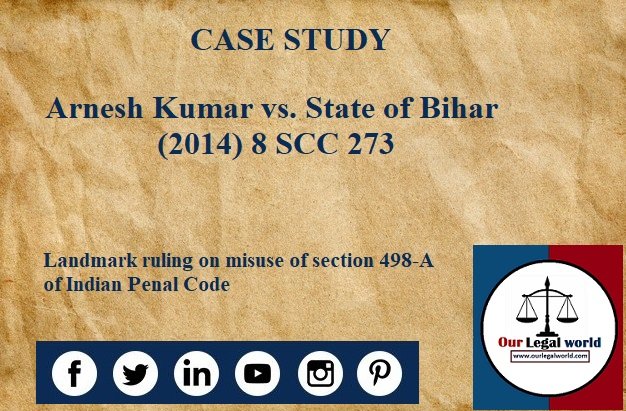Arnesh Kumar vs. State of Bihar (2014) 8 SCC 273: Case Study
Introduction:
Section 498-A of IPC states that:
Whoever, being the husband or the relative of the husband of a woman, subjects such woman to cruelty shall be punished with imprisonment for a term which may extend to three years and shall also be liable to fine.[1]
Essential ingredients of section 498-A:
- Woman must be married
- Woman is subjected to cruelty or harassment
- Such cruelty and harassment must have been inflicted either by Husband or relatives of husband.
Section 498-A of the Indian Penal Code has been brought into existence for defending women right and protect woman from cruelty.
But in the recent times Section 498-A has been subjected to the episode of misuse of power on the part of woman and there is a need to check the tendency of women to rope in all family members related to the crime of demanding dowry.
Facts Of The Case:
- The marriage between the Petitioner hereinafter referred as (Arnesh Kumar) and Respondent No.2 hereinafter referred as (Sweta Kiran) was solemnised on dated 1st July 2007. Arnesh Kumar was arrested under the provision of Section 4 of Dowry Prohibition Act 1961 after his wife Sweta Kiran affirmed that the petitioner has requested/ demanded dowry from her.
- The said Respondent i.e. Sweta Kiran alleged before the court and levelled allegations that petitioner family has made a demand of Rupees 8 Lakhs, a maruti Car, an Air-conditioner, television Set etc. When Sweta Kiran brought the fact in the petitioner notice he supported his family member and threatened to marry another woman if the demand was not fulfilled.
- Denying all the allegations made by the respondent, Petitioner applied for the anticipatory bail which was earlier rejected by Court of Session and thereafter by the High Court. Aggrieved from the order rejecting the anticipatory bail, Petitioner by way of Special Leave Petition appealed to the Supreme Court.
Issues raised:
The only issue that was involved in this particular case was the grant of anticipatory bail. The Anticipatory bail was not granted by the High Court. The case further deals with two of the most important issues i.e.
- Right of accused person before and after arrest
- What are the remedies that is left to a person when there is a misuse of Section 498-A of the Indian Penal Code by women.[2]
Arguments raised by the side of defendant:
- It has been alleged that she was driven out of the matrimonial home due to non-fulfilment of the demand of dowry.
Arguments raised by the side of petitioner:
- The fact that Section 498-A IPC is a cognizable and non-bailable offence has lent it a dubious place of pride amongst the provisions that are used as weapons rather than shield by disgruntled wives.
Judgement:
The Supreme Court by way of its judgement has granted provision bail to the petitioner on certain grounds. In this landmark judgment the Court not only granted bail, but also discussed and touched upon those aspects which were not dealt earlier i.e. misuse of Section 498-A of the Indian Penal Code. The court ended up with its judgment by passing some directions and guidelines as to how the arrest have to be made and the police officers and also magistrates has to follow those directions, such that there is no misuse of power.
While making the analysis of this judgement I have divided the context into two parts i.e. the observation context of the judgement where Supreme Court has given observation with regard to misuse of Section 498-A and Arrest of person under those section. While the mandatory direction part deals with the directions issued by the Supreme Court with regard to arrest under the Section of 498-A of the Indian Penal Code.
Observation Context:
The Supreme Court while dealing with the issue of grant of anticipatory bail with regard to an offence under section 498-A of the Indian Penal Code first of all highlighted the misuse of Section 498-A and observed that:
Section 498-A was introduced with a prime object to combat the harassment and cruelty of woman at the hands of her husband and his relatives. The offence under Section 498-A is Cognizable and Non-Bailable which has made it a dubious place of pride amongst the provisions that are used as weapons rather than a shield by disgruntled wives.[3] The simplest way to harass is to get the husband and his relatives arrested under this provision. In a quite number of cases bed ridden grand-fathers and grand-mothers of the husband, their sister living abroad for decades are arrested.
The Supreme Court also referred to the Crime in India Statistics published by National Crime Records Bureau by Ministry of Home Affairs. The data shows that 1, 97,762 persons were arrested in the year 2012 for the offence under Section 498-A of the Indian Penal Code and out of which 47,951 were women which depicts the mother and sister of the husband that are caught in the net of this offence. The rate of filing charge sheet for the offence under section 498-A is 93.6% while the conviction rate is only 15% which may likely states that in pending trial maximum cases would end up in acquittal. [4]
The Supreme Court thereafter made observation with regard to arrest. Supreme Court observed that:
Arrest brings humiliation, curtails freedom and cast scars forever. Law makers know it so also the police. There is a battle between the law makers and the police and it seems that police has not learnt its lesson; the lesson implicit and embodied in the code of criminal procedure. It has not come out of its colonial image despite six decades of independence; it is largely considered as a tool of harassment, oppression and surely not considered a friend of public.
The need for caution in exercising drastic power of arrest has been emphasized time and again by the courts but has not yielded the desired result. Power of arrest greatly contributes to its arrogance so also the failure of the Magistracy to check it. Not only this, the power of arrest is one of the lucrative sources of police corruption. The attitude to arrest first and then proceed with the rest is despicable. It has become a handy tool to the police officer who lack sensitivity or act with oblique motive.
Mandatory provisions:
The Supreme Court of India, in order to ensure that police officer do not arrest the accused unnecessarily and magistrate do not authorize detention, the Court giving the following directions:
- All the State Government should instruct its police officers not to automatically arrest a person when an offence under section 498-A of the Indian Penal Code is registered. The necessity of arrest arises when the case falls under the parameter of section 41 of the Code of Criminal Procedure.
- All police officers be provided with the check list containing specified clauses under Section 41 (1) (b) (ii)[5].
- The police officer shall forward the check list duly filed and furnished with the reason and material necessitated the arrest while producing accused before the magistrate for further detention.
- The magistrate while authorizing the order of further detention shall rely upon the report furnished by the police officer and only after recording the reason duly furnished on Police report and on the satisfaction, the Magistrate will authorize further detention.
- The decision not to arrest an accused be forwarded to Magistrate within two weeks from the date of institution of the case with a copy of Magistrate which may extended by the Superintendent of police of the district for the reason to be recorded in writing.
- Notice of Appearance in terms of Section 41-A of the Code of Criminal Procedure be served upon the accused within two weeks from the date of institution of case which may be extended by the Superintendent of Police after recording the reason in writing.
- Failure to comply with the directions mentioned above shall rendered the police officer liable to be punished for contempt of court before High Court having jurisdiction.
- Authorizing detention by the Judicial Magistrate without recording the reason, the concerned Judicial Magistrate shall be liable for Departmental Proceedings by the High Court.
Analysis / appreciation of the judgement:
The order by the Honourable Supreme Court judge to include all such offence under the ambit of the existing amended criminal procedure code act 1973 with relevant sections such as sec 41 and sec 41 A along with the guideline and conditions as directed by the current case order, ensures arbitrary arrest and the follow up by both police and magistrate with written reason ensures there is accountability and transparency. This will ensure less reliance of bails and arrest where its not needed . Most of the inference by the Honourable Supreme court judge in his reasoned order includes all these points.
Conclusion:
The current case throws open the debate that what is useful can also be a tool of harassment and it is this misuse one must curb. No legislation is passed with bad intent, but if the same is used against the actual ideal by way of manipulation then appropriate check have to be invoked to maintain a balance. It is therefore , incumbent that if all self regulate then the need of imposed regulation is minimized. Let’s all pave way for a better and evolved society in consonance with the ideals of the constitution , which “we the people” have given to ourselves.
Arnesh Kumar vs. State of Bihar (2014) 8 SCC 273: Case Study Written by Ishika Agrawal
[1] https://www.indiacode.nic.in/show-data?actid=AC_CEN_5_23_00037_186045_1523266765688§ionId=46286§ionno=498A&orderno=562
[2] https://www.jusdicere.in/arnesh-kumar-v-state-of-bihar-2014-8-scc-273/#:~:text=Arnesh%20Kumar%20v.-,State%20of%20Bihar%20%5B(2014)%208%20SCC%20273%5D,of%20the%20Dowry%20Prohibition%20Act.
[4] https://aalilegal.org/judgements-other-important-laws/arnesh-kumar-vs-state-of-bihar/
[5] Scconline.com






![Tax Law Internship at Legum Attorney [Chamber of Ashish Panday], Delhi : Apply by 15th May 2025](https://www.ourlegalworld.com/wp-content/uploads/2025/05/IMG_0113-min.png)

